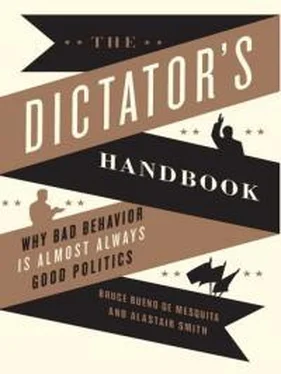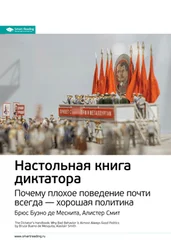Delegated positions also make it easier to form a small coalition. Consider Tanzania’s Parliament, the Bunge. There are 232 directly elected seats, seventy-five seats reserved for women who are nominated by the parties in relation to the number of seats they capture in the election, and five seats nominated by the Zanzibar Assembly. (Zanzibar is a beautiful island off the mainland that united with mainland Tanganyika in 1964 to form Tanzania.) In addition, the president gets to nominate ten cabinet appointees and an attorney general to serve in parliament. This gives a total of 323 seats, of which the president needs 162 to control the Bunge. Given that he appoints eleven, and that the CCM is regionally based in Zanzibar, he already controls sixteen seats. If the CCM wins 111 elected seats, then he controls parliament. That is, 111 directly elected seats, 16 appointed seats, and 35 of the appointed women’s seats (75 seats x 111/232), which totals 162. The CCM needs substantially less than half the directly elected seats. And as we have already seen, by funding many opposition parties the CCM can win many seats with less than a 10 percent vote share. In practice the president controls nearly all the women’s appointments and he tends to appoint women who lack an independent base of support. Indeed, few women win direct election to Tanzania’s parliament.
While Tanzania has free and fair elections, the reality is that the incumbent CCM party can sustain itself in office with as little as 5 percent of the vote. Of course, in most districts they get much more support because politicians find inventive ways to incentivize voters. One of these ways is the creation of voting blocs.14
Bloc Voting
Bloc voting is a feature common in many fledgling democracies. It was also the norm under party machines in large US cities. For instance, under the influence of Tammany Hall, whole neighborhoods in New York City would turn up to vote Democratic. Many of India’s electoral districts have followed a pattern similar to the old Tammany Hall. That is, a small group of local notables or village patrons can deliver their community’s vote and extract great rewards for themselves in return.
During Bueno de Mesquita’s time doing field work in India in 1969–1970 he observed firsthand how the quest for power coupled with the influence of power blocs undermined any notion of the pursuit of political principles other than the principles, win, and get paid off.
Senior people in villages and towns, and indeed, up and down the levels of governance in India’s states, would pledge to a particular party the support of those they led. In return, they would receive benefits and privileges. By and large, all the “clients” of these “patrons” followed their patron’s lead and voted for the designated party. What is most fascinating is that the affiliations between voters and parties need not have had any ideological rhyme or reason. In Uttar Pradesh, India’s most populace state, for instance, the free-market, anticommunist Swatantra Party, the socially conservative and anticommunist Jana Sangh Party, and the Communist Party of India formed a coalition government with each other following India’s 1967 election. This was true despite the Swatantra Party’s leadership’s description of the Communist Party of India as “public enemy number 1.” What did these parties have in common? Only their desire to band together and beat the Congress Party so as to enjoy the benefits of power. This sort of odd bedfellows coalition-building strategy was long rampant throughout India.15
Perhaps the most egregious case of bald opportunism occurred in the state of Bihar. There ideologically disparate parties formed a government, relying heavily on currying favor with the Raja of Ramgarh. The raja, owner of much of the mining interests in Bihar, switched parties every few months, bringing coalition governments down—and up—with him. Each time he switched, he garnered greater private goods for himself and his backers, including the dismissal of criminal charges against him. As the newspaper, The Patriot , reported on June 26, 1968, following one of the raja’s frequent defections to an alternative coalition, leading to the formation of a new government, “The Raja who had been able to get his terms from Mr. Mahamaya Prasad [the former head of the Bihar government] assumed that he could demand from Mr. Paswan [the new head of the Bihar government] a higher price. This amounted to Deputy Chief Ministership and the Mines portfolio for himself and withdrawal of the innumerable cases filed against him and members of his family by the Bihar government.” 16 The raja understood that he could manipulate his bloc of backers to make and break governments and, in doing so, he could enrich himself a lot and help his followers a little bit in turn. That, indeed, is the lesson of bloc voting whether based on personal ties in Bihar, trade union membership among American teachers, tribal clans in Iraq, linguistic divisions in Belgium, or religion in Northern Ireland. Bloc leaders gain a lot, their members gain less, and the rest of society pays the price.
Bloc voting takes seemingly democratic institutions and makes them appear like publicly traded companies. Every voter or share has a nominal right to vote, but effectively all the power lies with a few key actors who can control the votes of large numbers of shares or deliver many votes from their village. Bloc voting makes nominally democratic systems with large coalitions function as if they are autocratic by making the number of influentials—that is, people whose choices actually matter—much smaller than the nominal selectorate of the rest of the voters. Since this is such an important aspect of winning elections we are obliged to explore how politicians do it.
The traditional approach has been to treat emerging democracies as patronage systems in which politicians deliver small bribes to individual voters. The New York Times , for instance, reported on September 17, 2010, in an article with the headline “Afghan Votes Come Cheap, and Often in Bulk,” that the typical price paid for an Afghan voter’s support was about $5 or $6. But the article also noted that widespread vote fraud probably made vote buying unnecessary in any event.
The explanation for fraudulent electoral outcomes based on vote buying in exchange for patronage is simple, but it is also incomplete. First, parties don’t bribe enough people, and second, once in the voting booth, voters can renege. Historically parties used to issue their own ballots. For instance, your party might print a ballot on pink paper. In such a way, party representatives could check that those who took bribes voted with pink ballots. Although we could fill a whole book with the tricks parties use to monitor vote choices, the reality is that today votes are likely to be anonymous, at least in real democracies.
Bribing voters works far better at the bloc level. Suppose there are just three villages, and suppose a party, call it party A, negotiates with senior community figures in the villages and makes the following offer: if party A wins it will build a new hospital (or road, or pick up the trash, send police patrols, plow the snow, and so on) in the most supportive of the three villages. Once a village elder declares for party A, voters in that village can do little better than support party A, even if they don’t like it. The reality is that there are so many voters that the chance that any individual’s vote matters is inconsequential. Yet, voters are much more influential about where the hospital gets built or whose streets get swept than they are about who wins the election. To see why, consider the case where two or three of the village elders declare in favor of party A and most voters in these villages go along with them.
Читать дальше












